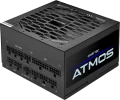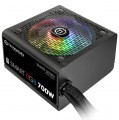Power
The output power of the power supply, in other words, is the maximum power that it is capable of delivering to the system. For the computer to operate efficiently, the power supply must be greater than the total power consumption of the system at maximum load. The latter can be calculated by summing the power of individual components, however, in general, for office configurations
, about 400 W —
450 W is considered sufficient, for medium gaming — about
600 W(
500 W,
550 W,
650 W,
700 W,
750 W), and for the top ones —
power of 800 W and above (
850 W,
1000 W and even
more than 1 kW).
Efficiency
Efficiency, in this case — the ratio of the power of the power supply (see "Power") to its power consumption. The higher the efficiency, the more efficient the power supply, the less energy it consumes from the network at the same output power, and the cheaper it is to operate. Efficiency may differ depending on the load; the characteristics can indicate both the minimum efficiency and its value at an average load (50%).
It should be noted that compliance with one or another level of 80PLUS efficiency directly depends on this indicator (for more details, see "Certificate").
Cooling system
—
1 fan. The most common option. The power of such a system is quite enough to cool the power supplies, including Above average and relatively inexpensive. On the other hand, fan operation creates noticeable noise, especially in low-cost power supplies with small diameter fans (see "Fan Diameter").
—
2 fans. The second fan is usually installed in powerful power supplies, for which the power of one fan is not enough. The price for such efficiency, in addition to increased cost, is an increased noise level.
— to
Semi-passive cooling. A function that allows you automatically turn off the PSU cooling system in situations where the load on the power supply is low and heat dissipation is reduced. It is found only in models with active cooling. Recall that systems of this type are more efficient than passive ones, but they consume additional energy and create noise during operation. Accordingly, at a light load, when intensive cooling is not required, it is more reasonable to turn off the fans — this saves energy and reduces the noise level.
—
Passive(radiators). Compared to fans, heatsinks have a number of advantages: for example, they do not create noise at all and do not require their own power supply (thus reducing overall power consumption). On the other hand, they are much less efficient, as a result — the power
...of power supplies with passive cooling does not exceed 600 watts. In addition, these PSUs are quite expensive.Fan bearing
The bearing is the piece between the rotating axle of the fan and the fixed base that supports the axle and reduces friction. The following types of bearings are found in modern fans:
— Sliding. The action of these bearings is based on direct contact between two solid surfaces, carefully polished to reduce friction. Such devices are simple, reliable and durable, but their efficiency is quite low — rolling, and even more so the hydrodynamic and magnetic principle of operation, provide much less friction.
— Rolling. They are also called "ball bearings", since the "mediators" between the axis of rotation and the fixed base are balls (less often — cylindrical rollers) fixed in a special ring. When the axis rotates, such balls roll between it and the base, due to which the friction force is very low — noticeably lower than in plain bearings. On the other hand, the design turns out to be more expensive and complex, and in terms of reliability it is somewhat inferior to both the same plain bearings and more advanced hydrodynamic devices. Therefore, although rolling bearings are quite widespread nowadays, however, in general, they are much less common than the mentioned varieties.
— Hydrodynamic. Bearings of this type are filled with a special liquid; when rotated, it creates a layer on which the moving part of the bearing slides. In this way, direct contact between hard surfaces is avoided and friction is significantly reduced compared to previous...types. Also, these bearings are quiet and very reliable. Of their shortcomings, a relatively high cost can be noted, but in fact this moment often turns out to be invisible against the background of the price of the entire system. Therefore, this option is extremely popular nowadays, it can be found in cooling systems of all levels — from low-cost to advanced.
— Magnetic centering. Bearings based on the principle of magnetic levitation: the rotating axis is "suspended" in a magnetic field. Thus, it is possible (as in hydrodynamic ones) to avoid contact between solid surfaces and further reduce friction. Considered the most advanced type of bearings, they are reliable and quiet, but expensive.
Certification
The presence or absence of an 80+ certificate for the power supply. This certificate indicates high energy efficiency: to obtain it, the efficiency (see above) must be at least 80%, and in different modes (20%, 50% and 100% of the maximum load). There are several degrees of 80+:
—
80+. The original version of the certificate, assuming an efficiency of at least 82% (at least 85% for 50% load).
—
80+ White. The second name of the original 80+ certificate (see above).
—
80+ Bronze — efficiency not less than 85% (for half load — 88%).
—
80+ Silver — respectively 87% (90% for half load).
—
80+ Gold — 89% (92% for half load)
—
80+ Platinum — 90% (94% for half load).
—
80+ Titanium — 94% (96% for half load).
The power factor (see "PFC Type") must be at least 0.9 for the lower levels and at least 0.95 for the Platinum level. Also note that for redundant power used in server systems, the efficiency requirements are somewhat lower.
ATX12V version
A standard for power supplies that supplements the ATX specifications regarding power supply along the 12 V line. Introduced into use since the time of the Intel Pentium 4 processor. In the first series of the standard, the +5 V line was mainly used; from version 2.0, the +12 V line was introduced to fully power the components computer. Also in the second generation, a 24-pin power connector appeared, used in most modern motherboards.
MB/CPU power supply
The number and type of connectors provided in the PSU to power the motherboard or processor.
This parameter is written as the sum of several numbers, for example, "24+4". The first number in such an entry means the number of contacts in the connector for powering the motherboard; in the vast majority of cases, this is just 24, since modern motherboards use a 24-pin connector as standard. The second number describes the socket for powering the processor; most entry-level and mid-range CPUs use 4-pin power, but powerful chips may require 8-pin power. There can be several 4- or 8-pin connectors — based on powerful high consumption processors.
A separate case is the blocks of the "24 (20 + 4)" format. They have two separate plugs — 20 pin and 4 pin, which allows you to power both 24-pin motherboards and older 20-pin motherboards from such power supplies. At the same time, such models do not provide a separate power supply for CPU — it is powered only through the socket, and the 4-pin plug cannot be connected to any other components except the motherboard.
Now on the market there are PSUs with such power supply for the motherboard:
24 pin (20+4),
24+4 pin,
24+8(4+4) pin,
24+8+8(4+4) pin.
SATA
The number of SATA power connectors provided in the PSU.
Nowadays, SATA is the standard interface for connecting internal hard drives, and it is also found in other types of drives (SSD, SSHD, etc.). Such an interface consists of a data connector connected to the motherboard, and a power connector connected to the PSU. Accordingly, in this paragraph we are talking about the number of SATA power plugs provided in the PSU. This number corresponds to the number of SATA drives that can be simultaneously powered from this model.
MOLEX
The number of Molex (IDE) connectors provided in the design of the power supply.
Initially, such a connector was intended to power peripherals for the IDE interface, primarily hard drives. And although the IDE itself is completely obsolete today and is not used in new components, however, the Molex power connector continues to be installed in power supplies, and almost without fail. Almost any modern PSU has at least
1 – 2 of these connectors, and in high-end models this number can be
7 or more. This situation is due to the fact that Molex IDE is a fairly universal standard, and with the help of the simplest adapters, components with a different power interface can be powered from it. For example, there are Molex - SATA adapters for drives, Molex - 6 pin for video cards, etc.

